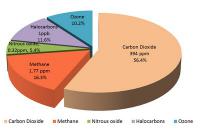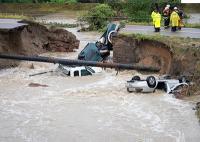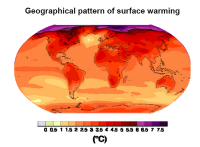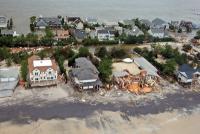-
Records: October, year-to-date hottest in human history
October 2015 was the hottest October in modern history, and the first ten months of the year have also set new records for worldwide warmth, U.S. government scientists at the National Oceanic and Atmospheric Administration (NOAA) said last week. The combined average temperature over global land and ocean surfaces for October 2015 was the highest for October in the 136-year period of record, at 0.98°C (1.76°F) above the twentieth century average of 14.0°C (57.1°F). The first ten months of 2015 comprised the warmest such period on record across the world’s land and ocean surfaces, at 0.86°C (1.55°F) above the twentieth century average, surpassing the previous record of 2014 by 0.12°C (0.22°F).
-
-
Small landscape changes can yield big freshwater gains
A typical bird’s-eye view of the Midwest offers a patchwork landscape covered mostly by agriculture but mottled with forest, wetland, grassland, buildings, and pavement. This pattern influences the quality and supply of the many natural benefits the landscape provides people, including freshwater. A new opportunity for improving the health and supply of Wisconsin’s lakes, waterways, and groundwater has emerged from a recent study showing that making small tweaks to how large some of those patches in the pattern are could mean big freshwater benefits, especially where making drastic changes to the landscape would be hard, as is the case throughout much of the state.
-
-
Global climate finance increases to $391 billion
A new report about the world’s inventory of climate finance shows that more money than ever before — at least $391 billion — was invested in low-carbon and climate-resilient actions in 2014. Private actors invested $243 billion in renewable energies, a surge of 26 percent from 2013, which resulted in record solar PV and onshore wind deployment. Public finance reached at least $148 billion continuing its steady growth over the past three years. Also, 74 percent of total climate finance ($290 billion) and 92 percent ($222 billion) of private investment was raised and spent in the same country. The domestic preference of climate finance highlights the importance of domestic investment policy and support frameworks.
-
-
Investment portfolios may take short-term hits as a result of climate change sentiment
A new report reveals that global investment portfolios could lose up to 45 percent as a consequence of short-term shifts in climate change sentiment. The report concluded that about half of this potential loss could be avoided through portfolio reallocation, while the other half is “unhedgeable,” meaning that investors cannot necessarily protect themselves from losses unless action on climate change is taken at a system level.
-
-
Declining snow packs put many nations' water supplies at risk

Gradual melting of winter snow helps feed water to farms, cities, and ecosystems across much of the world, but this resource may soon be critically imperiled. Scientists have identified snow-dependent drainage basins across the northern hemisphere currently serving two billion people that run the risk of declining supplies as a result of global warming. “Water managers in a lot of places may need to prepare for a world where the snow reservoir no longer exists,” one scientist says.
-
-
Greenhouse gas concentrations in the atmosphere hit another record

The amount of greenhouse gases in the atmosphere reached yet another new record high in 2014, continuing a relentless rise which is fueling climate change and will make the planet more dangerous and inhospitable for future generations, according to the World Meteorological Organization (WMO). The pre-industrial level of CO2 — of about 278 ppm — represented a balance between the atmosphere, the oceans, and the biosphere. Human activities such as the burning of fossil fuels has altered the natural balance, and in spring 2015, the global average concentration of CO2 crossed the 400 ppm barrier. The global annual average is likely to pass 400 ppm in 2016.
-
-
Climate change adaptation – from local initiatives to national policies
We all know that the climate is changing, but how can we best prepare for some of the changes that lie ahead? Should coastal cities change their building codes to accommodate rising sea levels? Should we allocate more resources to tree-planting to reduce urban heat islands? These are examples of local initiatives that can make a difference to climate change adaptation. Indeed, climate adaptation is a rapidly growing concern for the international community.
-
-
Human-caused climate change increased severity of many extreme events in 2014

Human activities, such as greenhouse gas emissions and land use, influenced specific extreme weather and climate events in 2014, including tropical cyclones in the central Pacific, heavy rainfall in Europe, drought in East Africa, and stifling heat waves in Australia, Asia, and South America, according to a new report released the other day. The report, Explaining Extreme Events of 2014 from a Climate Perspective, published by the Bulletin of the American Meteorological Society, addresses the natural and human causes of individual extreme events from around the world in 2014, including Antarctica.
-
-
Global temperatures set to reach 1 °C marker for first time

Met Office, the U.K. official weather service, says that data for 2015 so far shows that, for the first time, global mean temperature at the Earth’s surface is set to reach 1 °C above pre-industrial levels. This represents an important marker as the world continues to warm due to human influence. It is estimated that up to 2,900 Gigatonnes of CO2 (GtCO2) can be emitted to have a likely (more than 66 percent) chance of limiting warming to below 2 °C. The Met Office notes that as of 2014, about 2,000 GtCO2 had already been emitted, meaning society has used about two thirds of the 2 °C budget. This gives an indication that we are already committed to some level of further warming.
-
-
Game for climate adaptation
An MIT-led project takes the adage “think globally, act locally” to heart by demonstrated a new method for getting local citizens and leaders to agree on the best ways of managing the immediate and long-term effects of climate change. The project got local citizens and officials in four coastal towns to engage in role-playing games about climate change tailored to their communities — which in coastal communities may include rising sea levels and increased storm surges that can lead to flooding.
-
-
In the world of finance, consideration of climate change is now mainstream
As climate changes become impossible to dismiss, how does the mainstream investor community respond? Are financial decisions taking full account of risks and opportunities related to climate change, or is the topic still virtually ignored in financial decision-making?
-
-
Blitz spirit needed to meet challenges like climate change: Dr. Hugh Hunt
Today’s engineers will need the kind of drive and determination shown by the great wartime innovators such as Sir Barnes Wallis and Sir Frank Whittle if they are to respond effectively to challenges such as climate change, Dr. Hugh Hunt told the Royal Academy of Engineering on Tuesday. Hunt compared today’s challenge of adapting to future climate change with the imperative to develop new technologies to tip the balance of military capability in favor of the Allies during the Second World War.
-
-
Update issued for southeast Florida regional sea level rise projections
The four-county Southeast Florida Regional Climate Change Compact (Compact) has prepared an update to the regional sea level rise projections used for important planning purposes. Overall, the update includes minor changes to the short-term curves, but a more significant increase in the mid-and long-term projections. The 2015 update estimates sea level rise of 6 to 10 inches by 2030, or 3 to 5 inches above average sea level in 2015. Predictions for the mid-term are between 11 and 22 inches of additional sea level rise by 2060, and longer-term between 28 and 57 inches by 2100.
-
-
New York proposes new sea-level rise projection regulations
New York State Department of Environmental Conservation (DEC) announced last week that to better prepare New York State coastal communities and business owners for extreme weather events like Superstorm Sandy three years ago, DEC is proposing new state sea-level rise projections which will help state agencies and project planners develop more resilient structures. “The sea-level rise projections DEC is proposing today reflect the best science available,” said DEC acting commissioner. “Sea level projections will help state agencies, developers, planners and engineers to reduce risks posed by rising seas and coastal storms over the next several decades.”
-
-
California releases plan for preparing the state for extreme effects of climate change

In response to a directive from California governor Edmund G. Brown Jr., the California Natural Resources Agency has been seeking public comment on a draft plan for how California will prepare for and adapt to the catastrophic effects of climate change, including extended droughts and wildfires, rising sea levels and increasingly extreme weather. The draft plan — Safeguarding California: Implementation Action Plans — identifies the state’s vulnerabilities to climate change and details steps that need to be taken across ten sectors including water, transportation, agriculture, biodiversity and habitat, emergency management, and energy.
-
- All
- Regional
- Water
- Biometrics
- Borders/Immig
- Business
- Cybersecurity
- Detection
- Disasters
- Government
- Infrastructure
- International
- Public health
- Public Safety
- Communication interoperabillity
- Emergency services
- Emergency medical services
- Fire
- First response
- IEDs
- Law Enforcement
- Law Enforcement Technology
- Military technology
- Nonlethal weapons
- Nuclear weapons
- Personal protection equipment
- Police
- Notification /alert systems
- Situational awareness
- Weapons systems
- Sci-Tech
- Sector Reports
- Surveillance
- Transportation
Advertising & Marketing: advertise@newswirepubs.com
Editorial: editor@newswirepubs.com
General: info@newswirepubs.com
2010-2011 © News Wire Publications, LLC News Wire Publications, LLC
220 Old Country Road | Suite 200 | Mineola | New York | 11501
Permissions and Policies
Editorial: editor@newswirepubs.com
General: info@newswirepubs.com
2010-2011 © News Wire Publications, LLC News Wire Publications, LLC
220 Old Country Road | Suite 200 | Mineola | New York | 11501
Permissions and Policies
